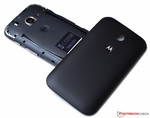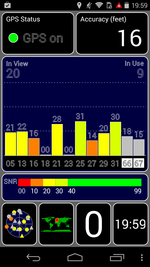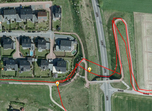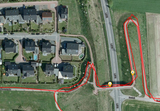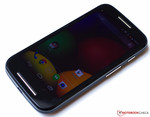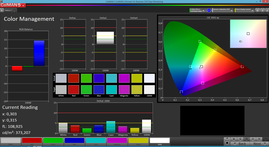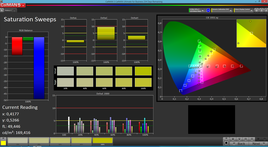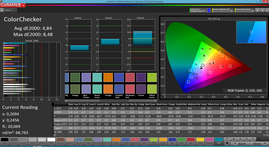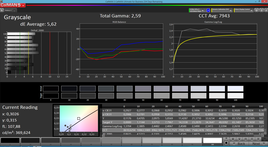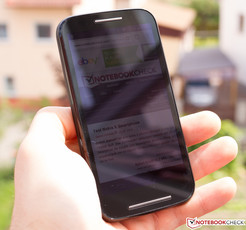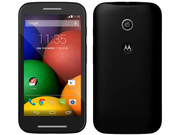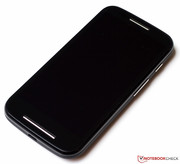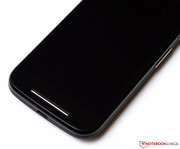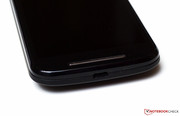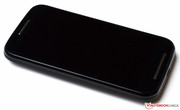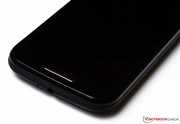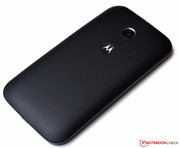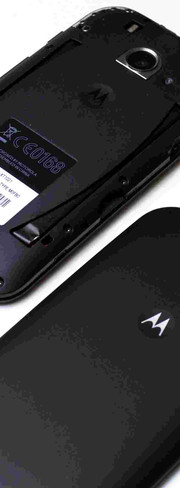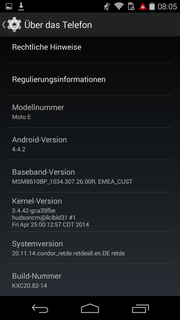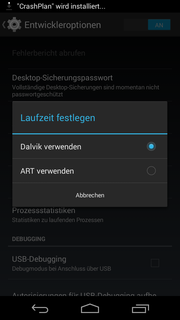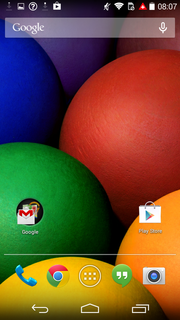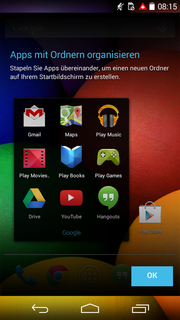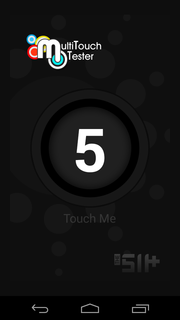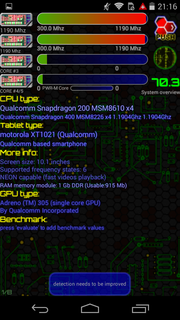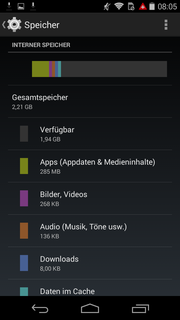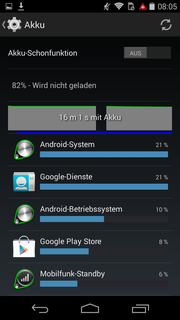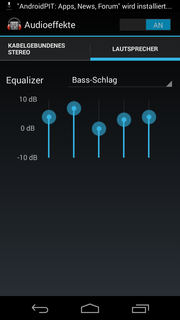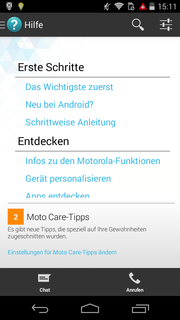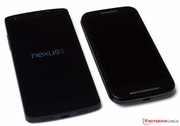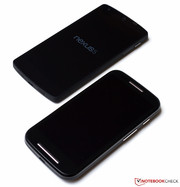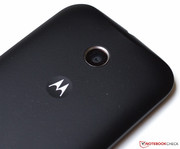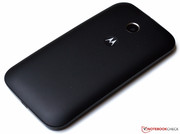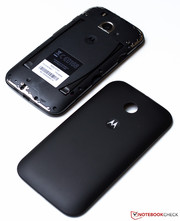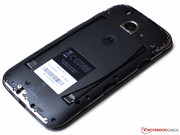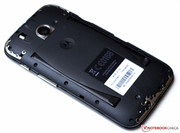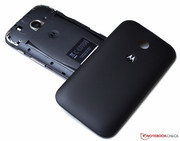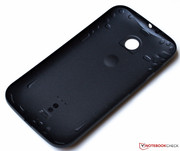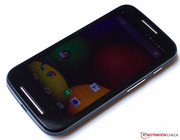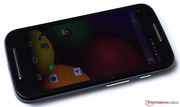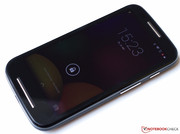Motorola Moto E Smartphone Review

For the original German review, see here.
For a number of years, nobody seemed to care much about Motorola. This changed abruptly with the release of the Moto G at the end of 2013. This great - and yet cheap (169 Euros (~$230) for the 8-GB version) - smartphone managed to not only convince us, but also the public, putting a lot of pressure on the competition. A lot has happened since that time, including the release of the Moto X and the concurrent sale of Google-owned Motorola to the Chinese PC manufacturer Lenovo (with only Motorola's patents remaining with Google). While we do not know Lenovo's exact plans for Motorola, it seems to be focused on offering even more affordable smartphones.
Now, the Moto E is supposed to further the success story of the Moto series that started with the Moto G, combining above-average specs with a below-average price of just 119 Euros (~$162). Everything has been shrunk a bit when compared to the Moto G. The display is smaller by 0.2 inches, the SoC is different (while still clocked at 1.2 GHz), the internal storage has been reduced to 4 GB, yet it is now expandable via MicroSD cards. This is indeed a truly interesting smartphone for a great price. If it were to impress as much as the Moto G did, the competition (including well-known brands) will have a truly hard time keeping market share in the entry-level segment.
Never change a winning team - that must be the reason why the chassis of the Moto E resembles that of the Moto G closely, even in terms of haptics. The one major difference is a noticeable speaker grille below the navigation bar, which is quite hard to overlook due to its silvery plastic. Again, the back cover can be removed within a few seconds, allowing access to the micro SIM and MicroSD card slots - unfortunately though; the battery cannot be replaced as easily. As was the case with the Moto G, the cover can be had in a number of colors. In addition, build quality of the Moto E is great, with superb torsion and pressure resistance.
The chassis has mainly just been shortened (by approx. 0.5 centimeters), down to 124.8 x 64.8 x 12.3 mm (~4.9 x 2.6 x 0.5 inches), with the rest of the dimensions having remained almost unchanged. The weight is the same, too - just one gram less. Our test device came with a black back cover and a black display frame. The front part can be had in white as well.
The locations of the buttons and the ports differ only slightly from those of the Moto G. Around the frame, only the micro USB port and the audio jack can be found on the two opposing short sides, while the power button and the volume rocker are positioned at the right.
As already mentioned, the Moto E ships with just 4 GB of storage space, with 2.2 GB remaining accessible to the user (after the OS is subtracted). This may sound like a catastrophe (nowadays, 2 GB is not even close to being enough, with some games requiring more than 1 GB of storage space), but thanks to the MicroSD card slot, this problem is averted. Even more so, it is a crucial advantage of the Moto E over the Moto G, which comes with either 8 GB or 16 GB of storage, but no MicroSD support.
Software
The Moto E ships with the most recent version of Android KitKat, with Android 4.4.2 being preinstalled. The rollout of Android 4.4.3 is supposed to commence soon, so we are already looking forward to seeing how fast Motorola will distribute the update for our test device. As with the models of the Nexus series, the feel and look of the UI has not been changed much at all, with an almost pure Android skin being used. This is great in terms of performance as the mid-range CPU is not throttled by unnecessary software additions. The few extra apps installed by Motorola do have their advantages, e.g. the "Assist" app which mutes the smartphone in accordance with pre-selected calendar events (for example, when being in a meeting) or even generally at night or while at work.
Some developers in the Android community have already managed to gain root access to the Moto E (prior to its official launch!), making it possible to sideload a custom recovery (TWRP). This development has actually somewhat been supported by Motorola, with the company releasing a "Bootloader Unlock Program" on its website.
Communication & GPS
When comparing the modem specs of the Moto G and the Moto E, there are only a few differences to be noted. The Wi-Fi module of the Moto E works with the 802.11 b/g/n standard, offering just the 2.4 GHz band. While different Wi-Fi modems can hardly be compared in rigorous tests (too many factors play a role), the transmission and reception performance is sufficiently good. Next to Wi-Fi networks, the Moto E can connect to the web via UMTS/HSPA+ (up to 21 Mbps with 850, 900, 1900 or 2100 MHz) - there is no LTE module.
Next to the low energy Bluetooth 4.0 LE module, a GPS module has been built into the Moto E, which even supports the Russian GLONASS standard. While determining the location may take up to a few minutes indoors, no more than one minute is required when being in the open. Compared to our professional navigation device made by Garmin (the Edge 500), 200 meters less (~220 yards) are registered during an outdoor bike tour of 12.16 km (~7.6 miles). Most of the inconsistencies occur in narrow curves (see "bridge") or in areas with reduced visibility and thus less satellites being found (see "forest"). Still, the overall result is quite respectable, as many high-end smartphones such as the Samsung Galaxy S5 and the Sony Xperia Z2 (which sell for four to five times the money) are not less error-prone and do not work much better.
Telephone Functions and Speech Quality
Many manufacturers offer ever larger displays - and while this may be great for browsing the web or watching movies, making phone calls becomes less and less comfortable (not even talking about the look of a phablet next to one's head, e.g. with the 6.44-inch Sony Xperia Z Ultra). The Moto E, on the other hand, can actually be called "small", barely being larger than the current iPhone. Much more important: Speech quality itself is great, with sufficient loudness, few distortions and no issues. Unfortunately, no headset is provided, which is a bummer since the speakerphone is not perfect, yielding mushy and somewhat distorted sounds.
Cameras & Multimedia
Well, costs have to be cut somewhere. One of these sacrifices was made with the front camera, which is non-existing. There is a rear camera (up to 5 megapixels, HD video with 720p and 30fps, no LED flash), however.
But not only does the sensor come with a rather low resolution, the camera of the Moto E is lackluster in most other regards, too (as was the one used in the Moto G). If a scene is well lit (e.g. outdoors and during the day), colors are reproduced accurately, but once low-light conditions dominate, the camera of the Moto E becomes mediocre at best, as can be seen below. Details vanish rapidly, making the camera usable for snapshots only. Expectations should adapt accordingly. Even when compared to low-end compact cameras, the Moto E does not stand a chance.
Accessories & Warranty
Motorola offers 12 months of warranty (with an additional 12 months being mandatory in a number of countries). Unsurprisingly, given the low price, there is not much else in the box: Just a USB cable. Even a power adapter would have to be purchased separately, if required (otherwise, the phone can only be charged via the USB port of a PC).
Input Devices & Handling
The capacitive multi-touch screen recognizes up to five fingers simultaneously, even in the corners of the display. Overall reaction speeds are decent (this extends to the orientation-sensor-based rotation of the display as well). Navigating the UI is done via three soft keys that are part of the 4.3-inch screen, reducing the actually usable screen real estate. Luckily, these keys are invisible in many apps (e.g. when looking at pictures, watching a movie or with many games) with the newest version of Android.
Thanks to the ability to root the Moto E, it is likely that a number of modifications to the user interface will be possible in the near future. For other smartphones, such as the Nexus 5 or the LG G2, the "Xposed Framework" as well as other apps can already change the size of the navigation bar as desired, yielding significantly more display area.
When compared to the Moto G, the cheaper sibling comes with a slightly smaller display (by 0.2 inches), but at the same time with far less resolution, yielding just 960x540 (qHD) pixels. Thus, the Moto E is not capable of displaying the best movie quality (720p) its internal camera is capable of producing. Nice: The display glass is actually Corning Gorilla Glass 3. Unfortunately, we cannot properly test its resistance to different materials, but we do suggest our readers not to try to test it either. According to Motorola's specs, the screen comes with an anti-smudge coating, but we would not have noticed this by ourselves.
With the help of the X-Rite i1Pro 2, we were able to measure an average brightness of 364.8 cd/m², somewhat less than the brightness of the Moto G (416.8 cd/m²), but still decent. Black levels, on the other hand, are good.
0.5 cd/m² may not be anything to write home about, but it suffices to beat the Moto G. Even better is the brightness homogeneity of the Moto E that reaches 96% - more than most high-end smartphones! Still, due to its lower brightness and just slightly better black levels, the contrast ratio of the Moto E (746:1) cannot quite reach the 817:1 of the Moto G.
| |||||||||||||||||||||||||
Brightness Distribution: 96 %
Center on Battery: 373 cd/m²
Contrast: 746:1 (Black: 0.5 cd/m²)
ΔE Color 4.84 | 0.5-29.43 Ø5
ΔE Greyscale 5.62 | 0.57-98 Ø5.3
Gamma: 2.59
As can be measured when looking at color rendition values, reds are a bit too dark and blues are a bit off. During our "ColorChecker" test, the two displays of the Moto E and the Moto G fare equally well (on average) with DeltaE 2000 values of 4.84 (Moto E) and 4.83 (Moto G). When looking at the grayscale rendition values, however, the Moto E takes the lead (by a large margin).
No display fares too well in direct sunlight, especially glossy, reflective ones, and even more so during the summer. The same holds true for the Moto E, but still, with the right angle and outside of direct sunlight, the screen contents remain somewhat legible. A matte display protector can be purchased separately, greatly improving the overall result.
The SoC of the Moto E is clocked at 1.2 GHz (similar to the Moto G), offering two cores. So where is the difference when compared to the Moto G? The GPU of the Moto E is weaker, with an Adreno 302 being used, being clocked at lower speeds than the Adreno 305 of the Moto G (which yields 450 MHz). That is not all, though: The SoC of our test device is a Snapdragon 200 made by Qualcomm (28 nm, ARMv7 commands), being supported by 1 GB of RAM.
With the help of a number of benchmarks (starting with the synthetic ones), we try to compare the internals of the Moto E to those of other devices, including a number of similarly-priced competitors as well as Samsung's current flagship, the Galaxy S5 - just to show what's possible if money is no issue. Nokia's first Android phone, the Nokia X, already loses its battle against the Moto E - all other low-level devices show similar performance as the Moto E, always competing for the top spots far behind the Galaxy S5. Again, our benchmarks show that clock speed is not everything - the Moto G outperforms the Moto E in almost every regard.
| 3DMark | |
| 1280x720 Ice Storm Standard Score (sort by value) | |
| Motorola Moto E 1. Gen 2014 | |
| Motorola Moto G 1. Gen XT1032 | |
| Samsung Galaxy S Duos 2 GT-S7582 | |
| Huawei Ascend Y530 | |
| Alcatel One Touch Pop C7 | |
| Nokia X | |
| 1920x1080 Ice Storm Extreme Score (sort by value) | |
| Motorola Moto E 1. Gen 2014 | |
| Motorola Moto G 1. Gen XT1032 | |
| Samsung Galaxy S Duos 2 GT-S7582 | |
| Huawei Ascend Y530 | |
| Alcatel One Touch Pop C7 | |
| Nokia X | |
| 1280x720 offscreen Ice Storm Unlimited Score (sort by value) | |
| Motorola Moto E 1. Gen 2014 | |
| Motorola Moto G 1. Gen XT1032 | |
| Nokia X | |
| Samsung Galaxy S5 | |
| AnTuTu v4 - Total Score (sort by value) | |
| Motorola Moto E 1. Gen 2014 | |
| Motorola Moto G 1. Gen XT1032 | |
| Samsung Galaxy S Duos 2 GT-S7582 | |
| Huawei Ascend Y530 | |
| Alcatel One Touch Pop C7 | |
| Nokia X | |
| Samsung Galaxy S5 | |
Another segment of benchmarks is those that are browser-based. Again, the picture remains the same. The Nokia X trails the pack; the others are more or less on par with each other. Surprising: The Moto E manages to stay very close to the Moto G, even beating it in a number of benchmarks. Of all the low-cost devices, the Galaxy S Duos 2 fares the best, taking the lead in these tests.
| Octane V1 - Total Score (sort by value) | |
| Motorola Moto E 1. Gen 2014 | |
| Motorola Moto G 1. Gen XT1032 | |
| Apple iPhone 5c | |
| Samsung Galaxy S Duos 2 GT-S7582 | |
| Alcatel One Touch Pop C7 | |
| Nokia X | |
| Mozilla Kraken 1.0 - Total (sort by value) | |
| Motorola Moto E 1. Gen 2014 | |
| Motorola Moto G 1. Gen XT1032 | |
| Samsung Galaxy S Duos 2 GT-S7582 | |
| Alcatel One Touch Pop C7 | |
| Peacekeeper - --- (sort by value) | |
| Motorola Moto E 1. Gen 2014 | |
| Motorola Moto G 1. Gen XT1032 | |
| Apple iPhone 5c | |
| Samsung Galaxy S Duos 2 GT-S7582 | |
| Huawei Ascend Y530 | |
| Samsung Galaxy S5 | |
| Sunspider - 0.9.1 Total Score (sort by value) | |
| Motorola Moto E 1. Gen 2014 | |
| Motorola Moto G 1. Gen XT1032 | |
| Samsung Galaxy S Duos 2 GT-S7582 | |
| Nokia X | |
* ... smaller is better
The Moto G came with surprisingly fast flash memory, even beating the Galaxy S5 in three out of four tests (and by a large margin!). Unfortunately, the 4 GB of storage used in our test device does not come close to these great values, especially during the sequential writing tests. Overall, the results are just average.
Games & Videos
Mission accomplished! Even though the benchmark results were nothing to write home about, video playback (even in Full HD quality) and most 3D as well as all 2D games are no major problem for the SoC, running smoothly - even though gaming does cause the Moto E to become quite warm.
Temperature
We are measuring its surface temperatures twice: Once under full load and once when idle. During the latter state, the temperatures remain low, just a bit higher than those of the Moto G, with 30.6 degrees Celsius at the front and 28.8 degrees at the back (87.08 and 83.84 degrees Fahrenheit respectively). Under load, however, things are different, with the heat reaching up to 39 degrees Celsius (102.2 Fahrenheit). This is quite noticeable and far worse than the Moto G, but it is not a deal breaker. Both the Huawei Ascend Y530 (32.1 degrees; 89.78 Fahrenheit at the front) and the Nokia X fare better under load.
(+) The maximum temperature on the upper side is 39.2 °C / 103 F, compared to the average of 35 °C / 95 F, ranging from 21.9 to 56 °C for the class Smartphone.
(+) The bottom heats up to a maximum of 34.9 °C / 95 F, compared to the average of 33.8 °C / 93 F
(+) In idle usage, the average temperature for the upper side is 30.6 °C / 87 F, compared to the device average of 32.7 °C / 91 F.
Speakers
The lower speaker is responsible for music playback while the upper one (even though it looks identical) is only being used when making phone calls. The maximum volume of the lower speaker is more than sufficient - or, to be put bluntly, too high, as tons of distortions develop, with the tinny sound becoming highly annoying rather quickly. The built-in equalizer helps in reducing this issue and adapting sound output to one's liking, but still, even though improvements can be done, an external speaker (which can be connected via Bluetooth, Wi-Fi or the 3.5mm audio jack) sounds far better.
Power Consumption
A crucial aspect when talking about battery life is the power consumption of the smartphone. Under load, between 2 and 2.5 Watts are reached, somewhat less than the Moto G with its 2.1 to 2.8 Watts. Things turn around when the phone is idle: 0.7 to 1.1 Watts is actually more than what the Moto G requires (0.4 to 1.0 Watts). While the lower power consumption of the Moto E under load can somewhat be explained with its smaller display and its lower maximum screen brightness (all devices are set to maximum brightness during the stress test), it is less certain what causes the Moto E to require more juice than Moto G when idle. Generally, the SoC and the display are the main culprits in such a case. Still, battery life is not solely determined by the power consumption of the device. The capacity of the battery comes into play, too.
| Off / Standby | |
| Idle | |
| Load |
|
Battery Life
The capacity of the battery of the Moto E is 1980 mAh, just 90 mAh less than that of the Moto G. Thus, the Moto E reaches the same running time under full load as the Moto G - a little more than 4 hours, quite a respectable achievement. And with 22 hours and 16 minutes while idle (modems deactivated, display brightness at minimum), the Moto E definitely has some above-average stamina as well while still falling three hours short of the Moto G. During our combined Wi-Fi test with medium brightness (150 cd/m²) and a script browsing the web, we managed to squeeze 14 hours out of the battery of the Moto E - much more than the approximately 8 hours of the Huawei Ascend Y530 and still more than what the Nokia X reaches.
Verdict
It seems to be so easy to sell numerous smartphones: Just provide a highly capable device with decent build quality and a low price. Then again, this may not be so easy to do, as many smartphones by many well-known manufacturers struggle to offer decent performance or other necessary features. The Moto G was one of the first smartphones that was not just cheap, but cheap and good at the same time - and this is what Motorola tries to achieve again with an even more affordable device, the Moto E - which sells for just 119 Euros (~$162). Unsurprisingly, this means that some cuts had to be made. The internal storage space has been reduced from 8 GB (or 16 GB) to just 4 GB - then again, it can now be expanded with MicroSD cards. The clock speed remains the same, but now a dual-core Snapdragon 200 with a weaker GPU (Adreno 302) is being used. The display has been downsized to 4.3 inches, yielding a qHD resolution.
In combination, an attractive Android smartphone (running KitKat 4.4.2!) comes into existence - which impresses with its great build quality, its recent Android version and its long battery life. Similarly priced smartphones such as the Huawei Ascend Y530 (Android 4.3) or the Nokia X (Android 4.1) do not come close, despite having their own virtues. Both devices sport bad displays (esp. with regard to their contrast ratios and black levels and, in the case of the Ascend Y530, viewing angles) and old Android versions. The latter aspect is a strong asset of Lenovo, thanks to its history as being a part of Google. Even Android 4.4.3 is supposed to be rolled out quickly (then again, we do not know about Lenovo's future plans concerning further upgrades). We were already impressed by what Motorola did with the Moto G, and we are not any less impressed by the Moto E. Both devices offer great value for the money. Still, one might want to ask oneself whether an extra 40 Euros (~$54; when purchased online) for the Moto G (8 GB) might not be such a bad investment - there are a number of advantages to the other, not-quite-as-cheap variant of the Moto series.


 Deutsch
Deutsch English
English Español
Español Français
Français Italiano
Italiano Nederlands
Nederlands Polski
Polski Português
Português Русский
Русский Türkçe
Türkçe Svenska
Svenska Chinese
Chinese Magyar
Magyar
